engine BUICK CENTURY 1994 Owners Manual
[x] Cancel search | Manufacturer: BUICK, Model Year: 1994, Model line: CENTURY, Model: BUICK CENTURY 1994Pages: 308, PDF Size: 16.3 MB
Page 6 of 308

Walter Marr and Thomas Buick
Buick’s chief engineer, Walter L. Marr (left), and
Thomas D. Buick, son of founder David Dunbar Buick,
drove the first Flint Buick in a successful Flint-Detroit
round trip in July 1904.
David Buick was building gasoline engines by 1899,
and Marr, his engineer, apparently built the first auto to
be called a Buick in 1900. However, Buick traditionally
dates its beginnings to 1903. That was the year the
company was reorganized, refinanced and moved from
Detroit to Flint. Buick has always been a product
innovator. Buick engineers developed the “valve-in-head”
engine, a light, powerful and reliable
engine which would eventually influence the entire
automotive industry.
William
C. Durant was instrumental in promoting
Buicks across
the country using his Durant-Dort
Carriage
Co. outlets and salespeople as the nucleus of a
giant distribution system.
He knew the Buick as a
“self-seller”.
If automobiles could be this good, he
thought, maybe
it was time to switch from the horse and
buggy business
to automobiles.
William C. (Billy) Durant
At the 1905, New York
Auto Show, Durant took orders
for 1,000 Buicks
before the company had
built
40. On Buick’s
success, Durant created a
holding company,
September 16, 1908. He
called it General Motors.
4
ProCarManuals.com
Page 7 of 308
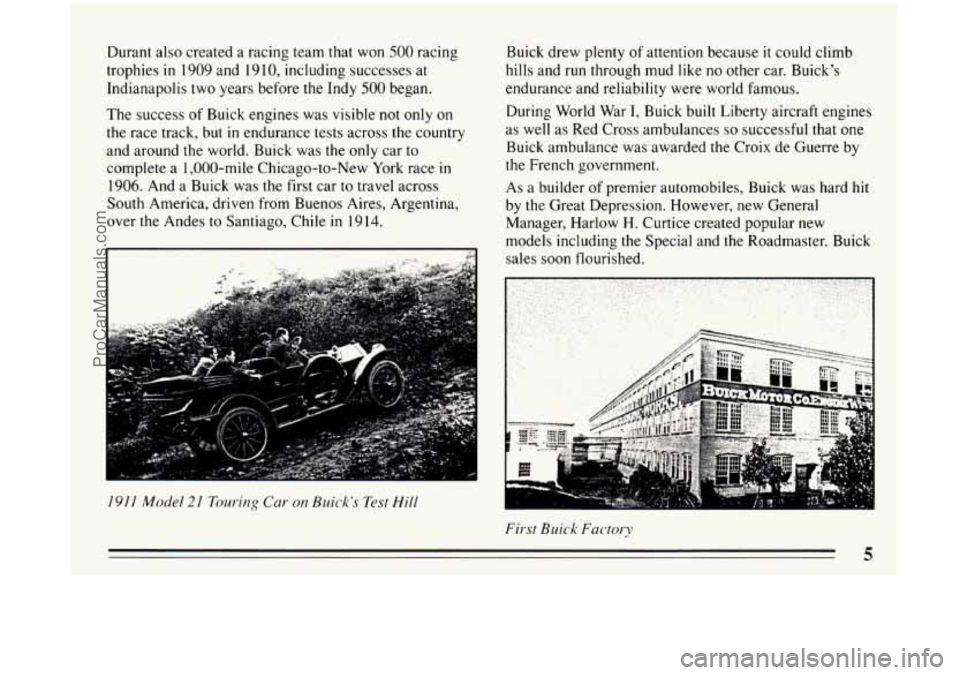
Durant also created a racing team that won 500 racing
trophies
in 1909 and 19 10, including successes at
Indianapolis two years before
the Indy 500 began.
The success
of Buick engines was visible not only on
the race track, but
in endurance tests across the country
and around the world. Buick was the only car to
complete a 1,000-mile Chicago-to-New York race
in
1906. And a Buick was the first car to travel across
South America, driven from Buenos Aires, Argentina,
over the Andes to Santiago, Chile in
19 14.
1911 Model 21 Touring Car on Buick’s Test Hill
Buick drew plenty of attention because it could climb
hills and run through mud like no other car. Buick’s
endurance and reliability were world famous.
During World War
I, Buick built Liberty aircraft engines
as well as Red Cross ambulances
so successful that one
Buick ambulance was awarded the Croix de Guerre by
the French government.
As a builder of premier automobiles, Buick was hard hit
by the Great Depression. However, new General
Manager, Harlow
H. Curtice created popular new
models including the Special and the Roadmaster. Buick sales soon flourished.
First Buick Factory
5
ProCarManuals.com
Page 8 of 308

In World War 11, Buick built aircraft engines, tanks and
other military hardware. This post-war period brought
great styling and engineering changes which resulted
in
increased sales. The torque converter automatic
transmission, Dynaflow, was introduced
in the 1948
Roadmaster. Buick’s famous “portholes” came along in
1949.
I949 Roadmaster
A high-compression V-8 engine was introduced in 1953.
And Buick’s famous vertical pillar “toothy” grille,
(introduced
in 1942), became more massive in the
post-war era.
I953 Skylark
Motor Trend magazine named the 1962 Buick Special,
“Car
of the Year”. The first production V-6 engine was
used
in the Special.
6
ProCarManuals.com
Page 11 of 308

@ Table of Contents
How to Use this Manual ................................................................ 10
This part tells you how to use your manual and includes safet\
y and vehicle damage warnings and symbols.
Seats and Restraint Systems ............................................................. 13
This part tells you how to use your seats and safety belts p\
roperly. It also explains the “SRS” system.
This part explains how
to start and operate your Buick.
This part tells you how to adjust the ventilation and comfort \
controls and how to operate your sound system.
YourDrivingandtheRoad .............................................................. 139
Here you’ll find helpful information and tips about the road\
and how to drive under different conditions.
ProblemsontheRoad .................................................................. 171
This part tells you what to do if you have a problem while driving, such as a flat tire or engine
overheating, etc.
Here the manual tells you how to keep your Buick running prop\
erly and looking good.
This part tells you when to perform vehicle maintenance and wh\
at fluids and lubricants to use.
This part tells you how to contact Buick for assistance and h\
ow
to get service publications. It also
gives
you information on “Reporting Safety Defects” on page 283.
Here’s an alphabetical listing of almost every subject in this manual. You can use it to quickly find
something
you want to read.
FeaturesandControls .................................................................. 65
Comfort Controls and Audio Systems ..................................................... 121
ServiceandAppearanceCare ............................................................ 207
Maintenanceschedule .................................................................. 261
Customer Assistance Information
........................................................ 281
Index
........................................................................\
........ 291
7
ProCarManuals.com
Page 14 of 308
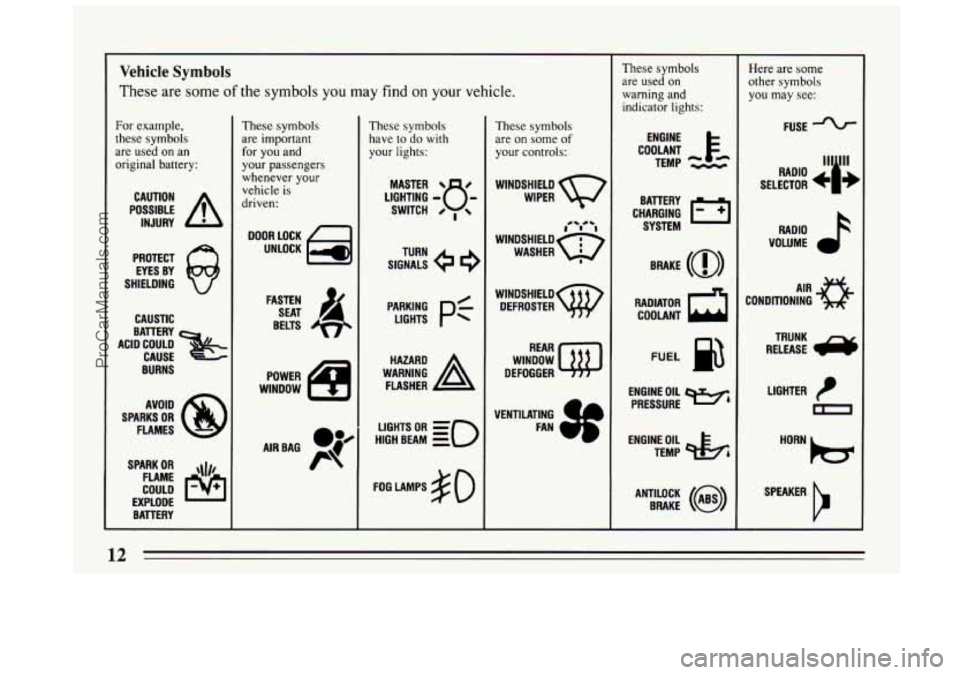
Vehicle Symbols
These are some of the symbols you may find on your vehicle.
Fur example,
these symbols
are used on an
original battery:
POSSIBLE A
CAUTION
INJURY
PROTECT EYES BY
SHIELDING
Q
CAUSTIC
BURNS AVOID
SPARKS
OR
FLAMES
SPARK
OR ,\I/,
COULD FLAME
EXPLODE BATTERY
These symbols
are important
for you and
your passengers whenever your
vehicle is
driven:
FASTEN SEAT 4
BELTS
POWER
WINDOW
AIRBAG P
These symbols have
to do with
your lights:
SIGNALS e
TURN
HIGH BEAM
OR = =o
FOG LAMPS $0
These symbols
are
on some of
your controls:
WIPER v
WINDSHIELDw DEFROSTER
WINDOW
DEFOGGER
VENTILATING FAN
These symbols
are used
on
warning and
indicator lights:
COOLANT F&
TEMP -.--
ENGINE
CHARGING
I-1
BAllERY SYSTEM
RADIATOR COOLANT
a
FUEL
ENGINE OIL e,
PRESSURE
TEMP
OIL 4%
ANTILOCK (@)
BRAKE
Here are some
other symbols
you may see:
FUSE
RADIO
k
VOLUME J
CONDITIONING A'R 0
RELEASE 6
TRUNK
LIGHTER
m
ProCarManuals.com
Page 67 of 308
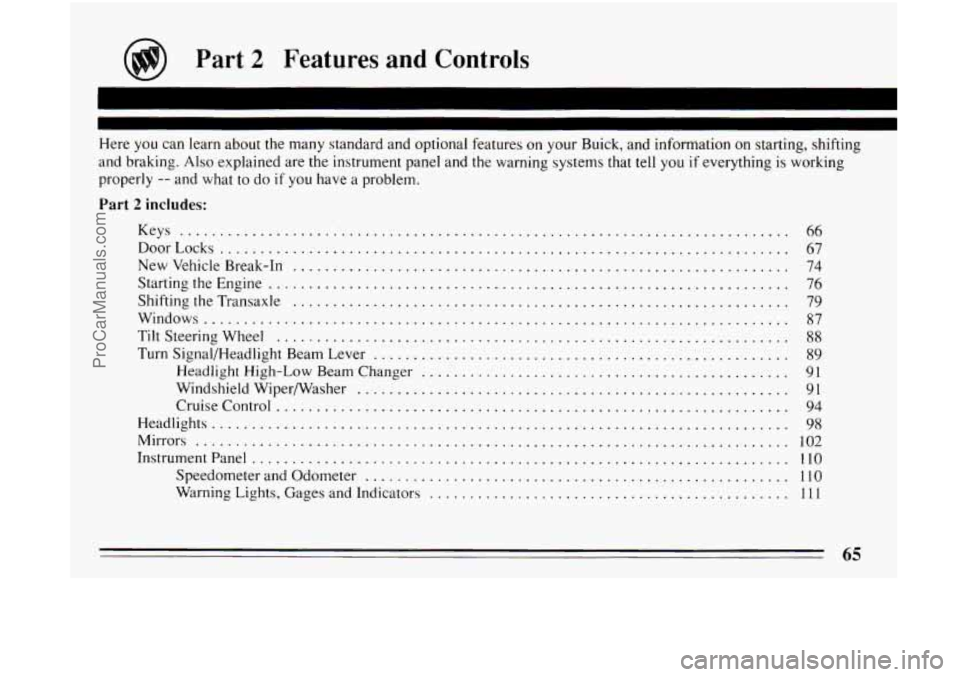
?art 2 Features and Controls
Here you can learn about the many standard and optional features on your Buick. and information on starting. shifting
and braking
. Also explained are the instrument panel and the warning systems that tell you if everything is working
properly
.. and what to do if you have a problem .
Part 2 includes:
Keys ........................................................................\
.. 66
DoorLocks .............................. ................................... 67
New Vehicle Break-In ..................... ..................................... 74
StartingtheEngine
................................................................. 76
ShiftingtheTransaxle ............................................................ 79
Windows ....................................................................... \
87
TiltSteeringWheel
................................................................ 88
Turn Signal/Headlight Beam Lever .................................................... 89
Headlight High-Low Beam Changer
.............................................. 91
Windshield Wipermasher ...................................................... 91
CruiseControl
................................................................ 94
Headlights
........................................................................\
98
Mirrors ........................................................................\
.. 102
Instrumentpanel ................................................................... 110
Speedometer and Odometer ..................................................... 110
Warning Lights . Gages and Indicators ............................................. 111
65
ProCarManuals.com
Page 77 of 308
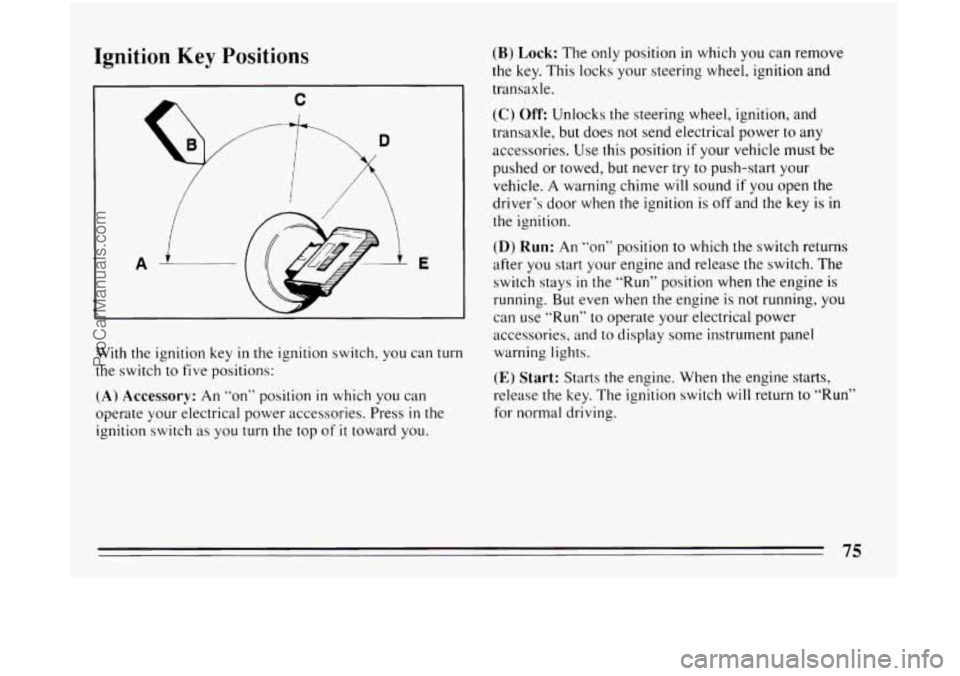
Ignition Key Positions
C
9.5 B
A i E
With the ignition key in the ignition switch, you can turn
the switch to five positions:
(A) Accessory: An “on” position in which you can
operate your electrical power accessories. Press
in the
ignition switch as you turn the top
of it toward you.
(B) Lock: The only position in which you can remove
the key. This locks
your steering wheel, ignition and
transaxle.
(C) Off: Unlocks the steering wheel, ignition, and
transaxle, but does not send electrical power
to any
accessories. Use this position
if your vehicle must be
pushed or towed, but never
try to push-start your
vehicle.
A warning chime will sound if you open the
driver’s door when the ignition is off and the
key is in
the ignition.
(D) Run: An ‘‘on’’ position to which the switch returns
after you start your engine and release
the switch. The
switch stays
in the “Run” position when the engine is
running. But even when the engine is
not running, you
can use
“Run” to operate your electrical power
accessories, and to display some instrument panel
warning lights.
(E) Start: Starts the engine. When the engine starts,
release the key. The ignition switch will return
to “Run”
for normal driving.
ProCarManuals.com
Page 78 of 308
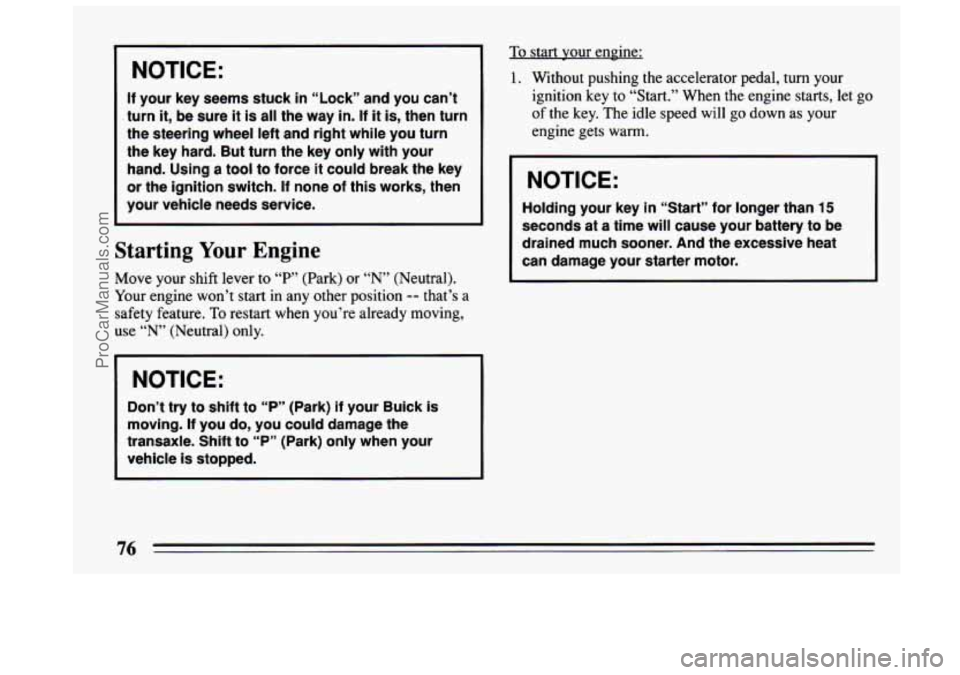
NOTICE:
If your key seems stuck in “Lock” and you can’t
. turn it, be sure it is all the way in. If it is, then turn
the steering wheel left and right while you turn
the key hard. But turn the key only with your
hand. Using a tool to force it could break the key
or the ignition switch. If none of this works, then
your vehicle needs service.
Starting Your Engine
Move your shift lever to “P” (Park) or “N” (Neutral).
Your engine won’t start in any other position
-- that’s a
safety feature. To restart when you’re already moving,
use
“N’ (Neutral) only.
NOTICE:
Don’t try to shift to “P” (Park) if your Buick is
moving.
If you do, you could damage the
transaxle. Shift to
“P” (Park) only when your
vehicle is stopped.
To start your engine:
1. Without pushing the accelerator pedal, turn your
ignition key to “Start.” When the engine starts,
let go
of the key. The idle speed will go down as your
engine gets warm.
NOTICE:
Holding your key in “Start” for longer than 15
seconds at a time will cause your battery to be
drained much sooner. And the excessive heat
can damage your starter motor.
76
ProCarManuals.com
Page 79 of 308
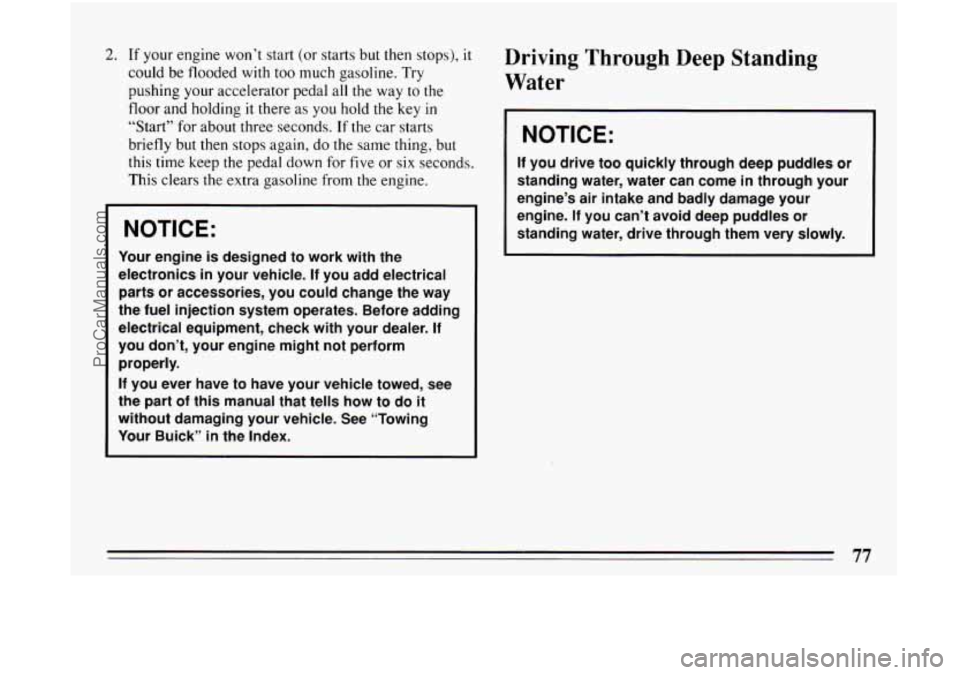
2. If your engine won’t start (or starts but then stops), it
could be flooded with too much gasoline. Try
pushing your accelerator pedal
all the way to the
floor and holding it there as you hold the key in
“Start” for about three seconds. If the car starts
briefly but then stops again, do the same thing, but
this time keep
the pedal down for five or six seconds.
This clears the extra gasoline from the engine.
I NOTICE:
Your engine is designed to work with the
electronics
in your vehicle. If you add electrical
parts or accessories, you could change the way
the fuel injection system operates. Before adding
electrical equipment, check with your dealer.
If
you don’t, your engine might not perform
properly.
If you ever have to have your vehicle towed, see
the part
of this manual that tells how to do it
without damaging your vehicle. See “Towing
Your Buick”
in the Index.
Driving Through Deep Standing
Water
I NOTICE:
If you drive too quickly through deep puddles or
standing water, water can come
in through your
engine’s air intake and badly damage your
engine.
If you can’t avoid deep puddles or
standing water, drive through them very slowly.
77
ProCarManuals.com
Page 80 of 308

Engine Coolant Heater (Engine Block Heater) (Canada Only)
In very cold weather, 0°F (-18°C) or colder, the engine
coolant heater can help. You’ll get easier starting and
better fuel economy during engine warm-up. Usually,
the coolant heater should be plugged
in a minimum of
four hours prior to starting your vehicle.
To use the coolant heater:
1. Turn off the engine.
2. Open the hood and unwrap the electrical cord.
3. Plug it into a normal, grounded 110-volt outlet.
I NOTICE:
After you’ve used the coolant heater, be sure to
store the cord
as it was before to keep it away
from moving engine parts. If you don’t, it could
be damaged.
How long should you keep the coolant heater plugged
in? The answer depends on the weather, the kind
of oil
you have, and some other things. Instead of trying to list
everything here, we ask that you contact a Buick dealer
in the area where you’ll be parking your vehicle. The
dealer can give you the best advice for that particular
area.
78
ProCarManuals.com